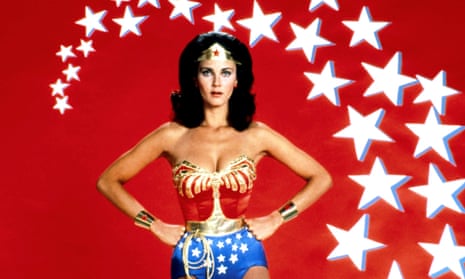How sexy should Wonder Woman be?
Quite sexy, according to cover artist Frank Cho. Cho drew a cover for Wonder Woman #3 which gives a view up Wonder Woman’s skirt so you can see a glimpse of her rear. (The image was cropped, apparently at writer Greg Rucka’s insistence, for the cover, but Bleeding Cool has the original sketch.)
Rucka objected, and Cho has quit the series in a huff.
Rucka, who did an acclaimed Wonder Woman run in the early 2000s, is known for his feminist slant on the character. Cho is best known these days for sexualized drawings of superheroines which are intended as an anti-feminist provocation. Putting Cho on a Rucka Wonder Woman series was a terrible idea from the start. It’s hard to believe the collaboration lasted one issue, much less six.
And yet, as inappropriate as Cho’s work was for Rucka, the fact is that Wonder Woman has, from her inception, been – well …
As you can see if you click the links, that’s an image of Wonder Woman being tied up by a shirtless guy, an image of Wonder Woman being tied up by a bunch of her sister Amazons, and an image of Wonder Woman winking while being paddled by a gigantic monstrous toddler.
Wonder Woman’s creator, William Marston, and artist Harry Peter, were not shy about putting sexual content in their comics. On the contrary, Marston was enthusiastic about it to the point of evangelism. Pick up any original Wonder Woman comic from the 40s, and you will see page after page of bondage, cross-dressing, tentacle high jinks, and eroticized sorority rituals. Also spanking. And foot fetish play. And hypnosis. Kink. It’s what Wonder Woman was about.

Marston’s kink wasn’t just kink, though. In his eyes, kink was the pathway to a utopian pacifist matriarchy. Marston was a psychologist with very particular, idiosyncratic views on sexuality. He believed that women were superior to men. Men, he believed, exercised power through violent subjugation; women exercised power through erotically tinged persuasion.
Marston saw Wonder Woman as a prototype of female “love leaders” who, through erotic oomph, could institute a peaceful matriarchal utopia. Wonder Woman’s lasso – an obvious and quite conscious yonic symbol – was originally a lasso, not of truth, but of control. It symbolized woman’s erotic power … and allowed for lots of kinky bondage imagery, of course. For Marston, erotic play with the lasso replaced violence, just as peaceful rule by female love leaders would eventually replace violent male patriarchy.
So, Frank Cho’s butt shot is the true essence of Wonder Woman, while Greg Rucka has betrayed her creator? Well, not exactly. In the first place, obviously, Cho’s intentions are a lot different than Marston’s were. Cho is not (I’m pretty sure) flipping up Wonder Woman’s skirt in order to usher in the feminist utopia. He’s just flipping up her skirt as a fan service reveal.
You could argue that sexualized Wonder Woman is sexualized Wonder Woman, whatever the intentions. But in this case, Cho’s sexy and Marston’s sexy are inflected in very different ways. In the first Marston/Peter image above, for example, the guy tying Wonder Woman up is showing more skin than she is; male bodies in Marston are often as sexualized as female ones. Marston was always aware, and appealing to, a female viewer as well as to a male one. This is especially the case since Marston lived in a polyamorous relationship with two almost certainly bisexual women: his wife, Elizabeth Marston, and their lover, Olive Byrne. When Marston shows Amazons tying each other up, as in the second image from the comics above, the lesbian connotations are absolutely intentional, and intended to appeal to women. Not least the women he lived with.
The last image, with the giant toddler paddling Wonder Woman, is an especially sharp contrast with Cho’s cover. Wonder Woman in the Marston/Peter image is not just sexualized; she’s aware that she’s sexualized. She outright winks at the viewer. The situation – paddled by giant toddlers while other babies look on – is absurd, but our heroine seems fully aware of that. She’s enjoying the age play while topping from the bottom.
In Cho’s drawing on the other hand, Wonder Woman’s body is uncomfortably rotated for the express purpose of letting you see up her skirt. Part of the fan service of the picture is that you’re seeing something she doesn’t intend, or plan, for you to see. She’s occupied with battling, and while she’s distracted, the viewer gets to sexualize her. It’s not Wonder Woman winking, but Cho – and what he’s winking about is that Wonder Woman isn’t in on the joke.
Rucka himself has an appreciation for Wonder Woman’s kinky legacy.
Sex is always going to be a part of Wonder Woman; Marston gave her bondage gear as weaponry, after all. But different artists can use Wonder Woman’s sexiness to mean different things. For Marston/Peter, sexiness was playful, powerful and the prototype of a particular (admittedly cranky) feminist vision. For Cho, sexiness is Wonder Woman not knowing people are looking up her skirt. That’s not particularly faithful to Marston’s vision – and apparently not to Rucka’s, either.

Comments (…)
Sign in or create your Guardian account to join the discussion